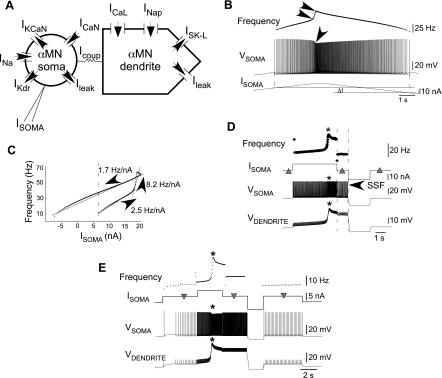Fig. 1.
Spinal cord injury (SCI) motoneuron model schematic and firing properties. A: model schematic showing the intrinsic and synaptic currents of the α-motoneurons (α-MN). Currents included in the model are the spike-generating fast sodium (INa) and delayed rectifier-type potassium currents (IKdr), medium afterhyperpolarization (mAHP)-generating N-type calcium (ICaN) and N-type calcium-activated potassium currents (IKCaN), leak potassium currents essential for stable resting potential (Ileak), L-type calcium (ICaL) and persistent sodium (INaP) persistent inward currents (PIC), sustained L-type calcium-activated potassium current (ISK-L), α-MN soma-injected current (Isoma), and α-MN soma and dendrite coupling current (Icoup). B: voltage (Vsoma) and frequency responses to somatic injection (Isoma) of triangular ramp current. Single arrow on Vsoma denotes spike acceleration, and double arrowheads on frequency denote a nonlinear increase in instantaneous spike frequency. Isoma needed to initiate discharge exceeds the value required to sustain discharge (ΔI), which is self-sustained (Bennett et al. 2001). C: injected current-frequency (I-f) relationship showing counterclockwise hysteresis and primary, secondary, and tertiary frequency ranges. The I-f slopes in the 3 frequency ranges are indicated. PIC activation accounts for the frequency augmentation in the secondary range and supports self-sustained α-MN discharge (frequencies to left of dashed vertical line). D: initial zero Isoma (left triangle) produces no α-MN discharge. A following depolarization activates dendritic plateau/PICs; somatic spikes concomitantly speed up, and firing frequency jumps up (note asterisks on Vdendrite, Vsoma, and frequency traces). A subsequent return of Isoma to zero (middle triangle) results in self-sustained firing (SSF) due to the sustained plateau (demarcated by dashed vertical lines). A subsequent hyperpolarization turns the plateau off and returns somatic and dendritic voltages to rest as Isoma again returns to zero (right triangle). E: Isoma without PIC activation (left inverted triangle) produces low-frequency firing; a subsequent greater Isoma activates PICs (near asterisk). Sustained PIC activation produces higher firing frequencies when Isoma is returned to its previous smaller value (middle inverted triangle). A subsequent hyperpolarization inactivates PICs, restoring low frequencies after Isoma returns to its original smaller value (right inverted triangle).

